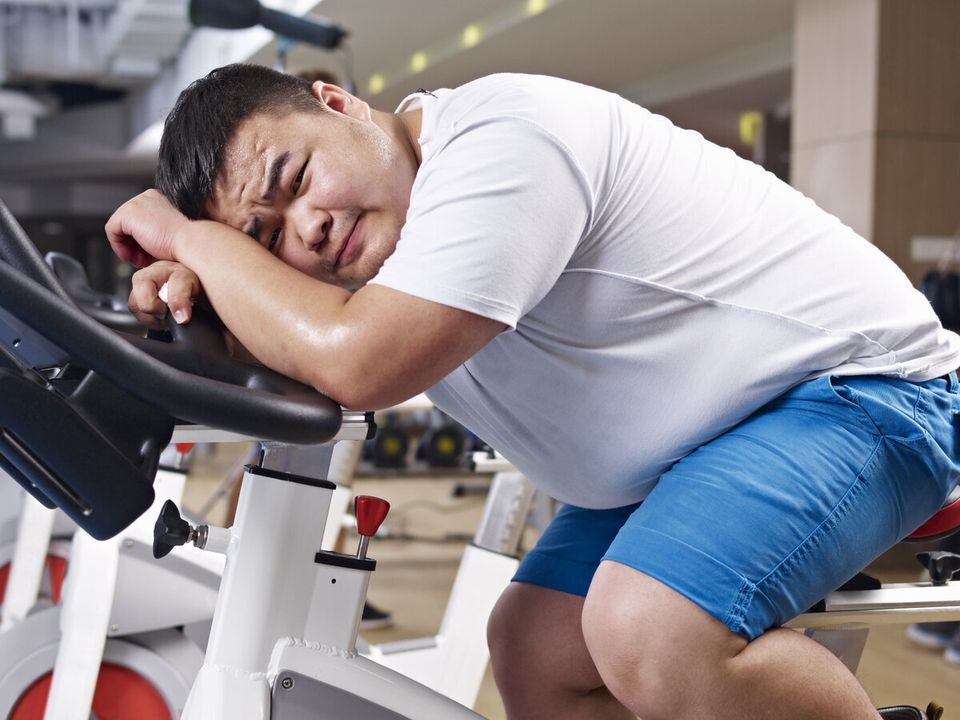

As a fitness trainer, I've seen a lot of bad fitness habits first-hand. I can tell you that not only are they bad habits, but they're also bad choices that could affect your long-term health. If you're guilty of any one of these, it's time to make a change.
Working Out On An Empty Stomach
The old theory used to be that you should train on an empty stomach in order to burn more fat. There are conflicting studies on whether this is true, but I'm in the camp that believes you should give your body fuel before you push it to the max. In fact, your body needs some glucose (blood sugar) for fuel in addition to what it can use from fat stores when you're working out. If you don't have any blood sugar available, your body can eat it's own muscle tissue to get glycogen for fuel once it runs out of available blood sugar or glycogen stores. Low blood sugar will also make you tired and sluggish — and maybe even dizzy — during your training session.
Most studies show that working out on an empty stomach will make you perform worse and keep you from having an intense workout. I suggest you eat something 45 minutes to an hour before training — you'll have more energy and endurance to work harder, burn more calories, and improve your muscle tone. Try eating low-fat yogurt with berries, a banana, or spread a few tablespoons of natural almond butter on apple slices. These are quick, healthy snacks that will provide your body with the fuel it needs for a hard-core workout.
Skipping Your Stretches
We were taught years ago to sit or stand and stretch one muscle group at a time before we train. Contrary to popular belief, that type of stretching is best saved for AFTER your workout, when your muscles are warmed up. To warm up the right way, perform five to 10 minutes of cardio (jog, elliptical, stationary bike, jump rope or jumping jacks etc.), then some form of dynamic stretching.
Stick with me here — dynamic stretching is basically stretching with motion, so your body gets a chance to warm up the muscles slowly and in a functional way. Think arm circles, leg swings and so on, but be sure not to bounce the stretch as you risk injury when you ballistic stretch. One of my favorite methods of dynamic stretching is butt kicks — here's how you do 'em:
Butt Kicks
Purpose: To stretch your quads.
The stretch: This can be done walking or jogging. As you walk or jog, exaggerate the knee bend so that you are trying to kick yourself in the butt. You want your knee to point straight to the ground as your heel comes toward your butt. Keep your arms pumping in the normal running motion.
Key point: The higher you get your heel and the more you keep your knee toward the ground (instead of coming up in front of you with hip flexion), the more of a quad stretch you'll get.
Avoiding Strength Training
Don't get me wrong, cardio is GREAT for your body. It gets your heart rate up, burns a lot of calories, and works a lot of muscles. But it's not the most effective way to burn the MOST calories. I'm a huge advocate of high-intensity circuit training and I use cardio intervals in my circuits in my online workouts and in my DVDs. A circuit is a series of exercises performed one after the other (about four to five) with little or no rest in between. For example, if you're doing push-ups, you're incorporating your shoulders, triceps, chest, and abs, and then you can go straight from your push-up set into a set of lunges. You've changed the muscle groups you're working, but you haven't stopped exercising.
Then you add high-intensity training (HIT) into the mix by throwing an intense cardio interval into your resistance-training circuits. For example, you add a minute of jumping rope, sprinting, or doing jumping jacks to jack up your heart rate and burn a ton of calories, and then you go back into the resistance-training sets. This way, you maximize BOTH your time and your calorie burn. When a set of these moves are done, you go back to the beginning and do them again before moving on to the next circuit.
A typical circuit-training workout will get your heart rate up and impact a variety of muscles — not just one body part. Then, you can constantly switch up your circuits to hit different areas of the body. Ladies, don't be afraid to add free weights into your routine! I hate it when women are hesitant to use weights because they're afraid of bulking up. Lifting weights is a critical way to boost your fat-burning potential and you won't bulk up unless you are lifting EXTREMELY heavy weights and eating far more calories than you are burning. I recommend you start with a weight you can lift with good form for 12 to 16 repetitions.
Getting Stuck In A Workout Rut
Often people have a routine that they do in the gym every time they go. This is bad for many reasons, most importantly of which your body will stop progressing. You see, your body adapts to the stimulus you subject it to. If you don't constantly change up your workout then you cheat your body of opportunities to get more fit. Think about it, you haven't trained in months and you do 20 squats. Well, the next day you'll be sore, but if you do 20 squats for 10 days in a row, by day 10 you won't be sore. That's because your body has adapted to it.
So, make sure that at least every two you weeks you change your routine. Try changing the types of exercises you are doing and playing with the amount of sets, reps, and weights you are lifting. Also, try adding new classes to your regimen like a spin class at Flywheel, boxing, CrossFit, bar method, dance, yoga, kettlebells etc. By training in different ways, your body becomes more efficient, well rounded, and less prone to injury. Break out of your comfort zone and try something new.
Not Working Out With Intensity
The intensity of your workout is crucial to burn fat. If you want results you need to give it your all. You give what you get! Forget about the "target fat burning zone". As I mentioned earlier, to get results fast intensity is key.
Get your heart rate up and working at 85 percent of your maximum. To calculate your maximum heart rate, if you're a woman, subtract your age from 220. If you're a man, subtract your age from 226. That number is your maximum heart rate in beats per minute. The ONLY time I give you permission to decrease the intensity is if you feel that you're working too hard to maintain proper form, which is a sure path to injury.
Not Knowing Your Limits
On the flipside of underperforming, is pushing yourself too hard. You always need to understand and be aware of your limitations. Injuring yourself can put you out of the game for weeks! Make sure to take the time to use proper form. If it's a really hard one, try a modification of the exercise.
If you injure a part of your body, you can still work around the injury (after consulting a doctor!), but there are some key points to remember. Generally speaking, if you have sustained an injury in your upper body, such as a rotator-cuff injury or torn biceps, for example, you can most likely do high-intensity, lower-body cardio like running, step, jump rope, elliptical, spinning, and so on. You can also continue to do exercises for your lower body, such as lunges, squats, leg presses, or dead lifts.
If your injury is in your lower extremities — knees, ankles, feet, shins, or calves — try low-impact forms of cardio such as swimming, recumbent biking, rowing, and shadow boxing with light weights in each hand. Again, generally speaking, you can also continue to do resistance-training moves for your upper body, such as back, chest, abs, and arm exercises.
